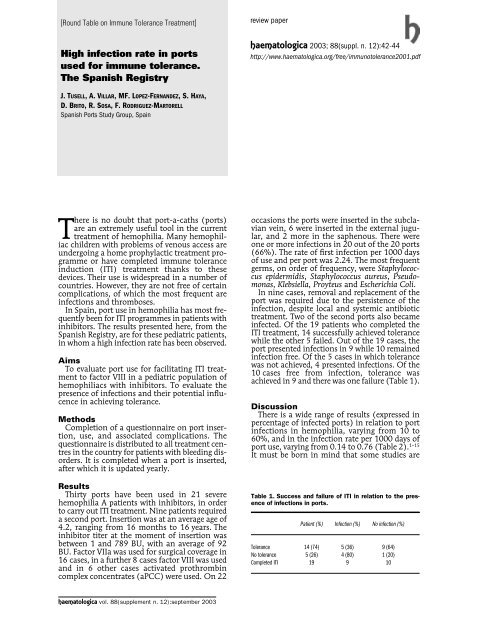2003; baxter - Supplements - Haematologica
2003; baxter - Supplements - Haematologica
2003; baxter - Supplements - Haematologica
- No tags were found...
You also want an ePaper? Increase the reach of your titles
YUMPU automatically turns print PDFs into web optimized ePapers that Google loves.
[Round Table on Immune Tolerance Treatment]High infection rate in portsused for immune tolerance.The Spanish Registryreview paperhaematologica <strong>2003</strong>; 88(suppl. n. 12):42-44http://www.haematologica.org/free/immunotolerance2001.pdfJ. TUSELL, A. VILLAR, MF. LOPEZ-FERNANDEZ, S. HAYA,D. BRITO, R. SOSA, F. RODRIGUEZ-MARTORELLSpanish Ports Study Group, SpainThere is no doubt that port-a-caths (ports)are an extremely useful tool in the currenttreatment of hemophilia. Many hemophiliacchildren with problems of venous access areundergoing a home prophylactic treatment programmeor have completed immune toleranceinduction (ITI) treatment thanks to thesedevices. Their use is widespread in a number ofcountries. However, they are not free of certaincomplications, of which the most frequent areinfections and thromboses.In Spain, port use in hemophilia has most frequentlybeen for ITI programmes in patients withinhibitors. The results presented here, from theSpanish Registry, are for these pediatric patients,in whom a high infection rate has been observed.AimsTo evaluate port use for facilitating ITI treatmentto factor VIII in a pediatric population ofhemophiliacs with inhibitors. To evaluate thepresence of infections and their potential influcencein achieving tolerance.MethodsCompletion of a questionnaire on port insertion,use, and associated complications. Thequestionnaire is distributed to all treatment centresin the country for patients with bleeding disorders.It is completed when a port is inserted,after which it is updated yearly.ResultsThirty ports have been used in 21 severehemophilia A patients with inhibitors, in orderto carry out ITI treatment. Nine patients requireda second port. Insertion was at an average age of4.2, ranging from 16 months to 16 years. Theinhibitor titer at the moment of insertion wasbetween 1 and 789 BU, with an average of 92BU. Factor VIIa was used for surgical coverage in16 cases, in a further 8 cases factor VIII was usedand in 6 other cases activated prothrombincomplex concentrates (aPCC) were used. On 22occasions the ports were inserted in the subclavianvein, 6 were inserted in the external jugular,and 2 more in the saphenous. There wereone or more infections in 20 out of the 20 ports(66%). The rate of first infection per 1000 daysof use and per port was 2.24. The most frequentgerms, on order of frequency, were Staphylococcusepidermidis, Staphylococcus aureus, Pseudomonas,Klebsiella, Proyteus and Escherichia Coli.In nine cases, removal and replacement of theport was required due to the persistence of theinfection, despite local and systemic antibiotictreatment. Two of the second ports also becameinfected. Of the 19 patients who completed theITI treatment, 14 successfully achieved tolerancewhile the other 5 failed. Out of the 19 cases, theport presented infections in 9 while 10 remainedinfection free. Of the 5 cases in which tolerancewas not achieved, 4 presented infections. Of the10 cases free from infection, tolerance wasachieved in 9 and there was one failure (Table 1).DiscussionThere is a wide range of results (expressed inpercentage of infected ports) in relation to portinfections in hemophilia, varying from 10 to60%, and in the infection rate per 1000 days ofport use, varying from 0.14 to 0.76 (Table 2). 1–15It must be born in mind that some studies areTable 1. Success and failure of ITI in relation to the presenceof infections in ports.Patient (%) Infection (%) No infection (%)Tolerance 14 (74) 5 (36) 9 (64)No tolerance 5 (26) 4 (80) 1 (20)Completed ITI 19 9 10haematologica vol. 88(supplement n. 12):september <strong>2003</strong>
















